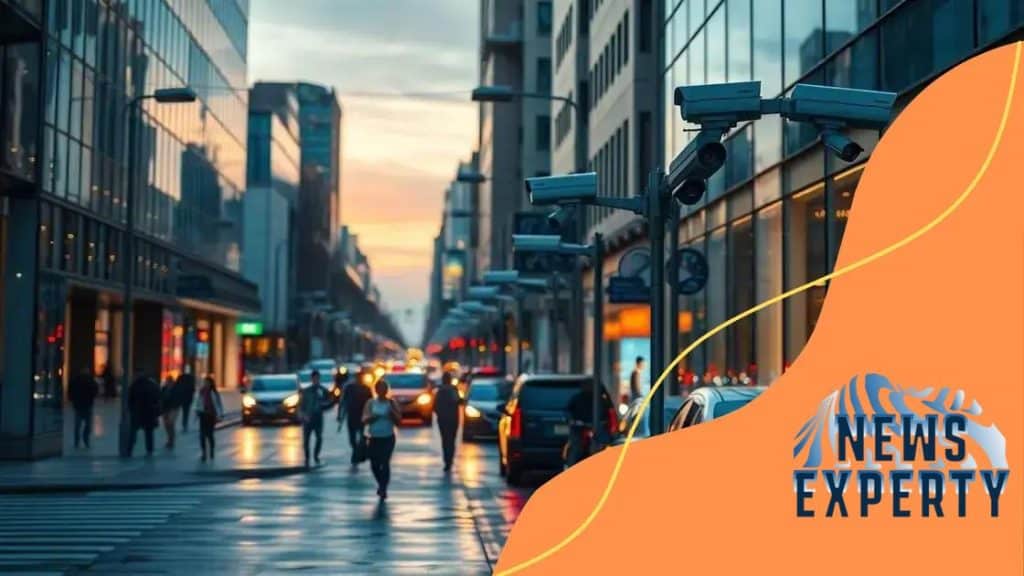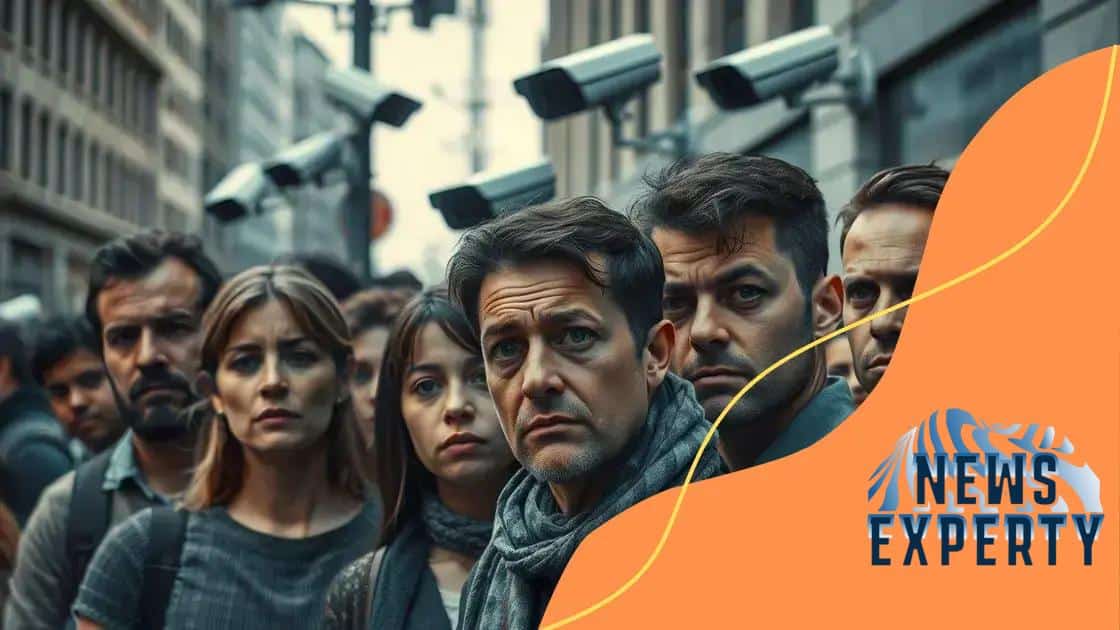The role of facial recognition in enhancing public safety

Anúncios
The role of facial recognition in enhancing public safety involves identifying individuals in real-time to prevent crime and improve security, while also raising significant privacy concerns.
The role of facial recognition in enhancing public safety has become a hot topic in recent years. From crowded events to city surveillance, this technology aims to protect and improve our communities. But how does it really affect us?
Anúncios
Understanding facial recognition technology
Understanding facial recognition technology is crucial in today’s digital age. This technology detects and recognizes human faces in images, videos, and real-time streams. It works by comparing facial features from a camera feed against a database of stored images.
This process starts with a detection. Cameras capture images, and algorithms identify faces from this data. Initially, the system marks key features of the face, such as the distance between the eyes or the shape of the jaw. These features create a unique template for each face, similar to a fingerprint.
How Does It Work?
Facial recognition technology operates using several key steps:
Anúncios
- Image Acquisition: Capturing images through cameras.
- Face Detection: Identifying human faces within the images.
- Feature Extraction: Measuring facial characteristics.
- Matching: Comparing the features to a database.
Once the features are extracted, they are converted into a mathematical representation. This allows the system to conduct comparisons quickly and accurately. However, it requires a good quality image; low-light or blurry conditions can hinder accuracy.
Applications of Facial Recognition
Facial recognition is being applied in various fields, each benefiting from this technology significantly:
- Security: Enhancing safety at events and crowded areas.
- Law Enforcement: Assisting in identifying suspects or missing persons.
- Retail: Recognizing customers for personalized experiences.
- Smartphones: Unlocking devices through facial IDs.
These applications show how versatile facial recognition technology has become. By understanding the process and its capabilities, we can appreciate its role in enhancing public safety.
Benefits of facial recognition for public safety
The benefits of facial recognition for public safety are significant and transformative. This technology enables law enforcement to respond faster to incidents, ensuring a safer environment for everyone. With its ability to quickly identify individuals in real-time, it plays a crucial role in enhancing security measures.
One of the most prominent advantages is its capability to assist in crime prevention. By monitoring crowded areas, facial recognition systems can detect suspicious activity and alert authorities immediately. This proactive approach can deter potential crimes, making public spaces safer.
Key Advantages of Facial Recognition
There are several key advantages of implementing facial recognition technology in public safety:
- Enhanced surveillance: Continuous monitoring helps keep communities secure.
- Rapid identification: Speedy identification of individuals allows for quick law enforcement response.
- Missing persons: Assisting in locating and identifying missing persons effectively.
- Event security: Ensuring safety at large public gatherings by identifying potential threats.
With the technology continuously improving, it provides enhanced accuracy and reliability. This means that authorities can trust the system to make informed decisions based on the data collected.
Additionally, facial recognition supports collaboration between different law enforcement agencies. By sharing data, they can create a comprehensive database that helps in tracking criminal patterns and enhancing community safety. These cooperative efforts are crucial in building a connected and safer society.
Privacy concerns regarding facial recognition

Privacy concerns regarding facial recognition technology are significant and widely discussed. As this technology becomes more integrated into public spaces, many people worry about its implications for personal privacy and civil liberties. The use of facial recognition can lead to tracking individuals without their consent, which raises serious ethical questions.
There are several specific concerns that people often express about facial recognition technology. Firstly, the potential for misuse is alarming. Government agencies and private companies can deploy this technology for surveillance, sometimes targeting vulnerable populations. This raises issues related to discrimination and bias.
Key Privacy Issues
Here are some of the main privacy issues tied to facial recognition:
- Surveillance: Constant monitoring can create a feeling of being watched.
- Data security: Collected images and data may not be secure and can be accessed by unauthorized users.
- Consent: Many individuals are unaware that their faces are being scanned and used.
- Bias: Facial recognition systems can exhibit biases based on race or gender, leading to unfair profiling.
Moreover, the lack of transparent policies surrounding data handling increases these concerns. People often feel unsure about how their data is stored and used. This uncertainty can lead to a distrust of both technology and institutions using it. There is a growing call for regulations to ensure that individuals’ rights are protected.
Additionally, public discussions about transparency and accountability in the use of facial recognition technology are essential. Implementing policies that protect privacy while addressing security needs is a balancing act that requires careful consideration.
Real-world applications in law enforcement
Real-world applications in law enforcement showcase the transformative power of facial recognition technology. This technology enables police and other authorities to enhance safety measures and respond quickly to incidents. By integrating facial recognition into their operations, law enforcement agencies can increase their efficiency and effectiveness in maintaining public order.
One key application is the use of facial recognition systems at large public events. These systems can identify and locate individuals who may pose threats, thereby preventing potential incidents before they occur. The ability to monitor crowds in real-time can create a safer environment for attendees.
Key Uses in Law Enforcement
Here are some prominent ways facial recognition is utilized:
- Suspect Identification: Quickly matching faces from surveillance footage to known criminals in databases.
- Missing Persons: Aiding in the search by identifying individuals who have been reported missing.
- Crime Scene Analysis: Reviewing footage from nearby cameras to find potential suspects or witnesses.
- Traffic and Parking Control: Monitoring for stolen vehicles or tracking licenses associated with outstanding warrants.
Facial recognition also facilitates collaboration between various police departments. By sharing data and resources, agencies can improve investigations and create a unified response to crime. For example, when one department identifies a suspect, they can quickly notify others in surrounding areas.
Despite its advantages, the technology does raise questions about privacy. Balancing the benefits of enhanced security with respect for citizens’ rights remains an ongoing discussion. However, when implemented thoughtfully, facial recognition can significantly enhance law enforcement’s ability to keep communities safe.
The future of facial recognition in community safety
The future of facial recognition in community safety holds exciting potential and significant challenges. As technology advances, communities can expect safer environments through enhanced security measures. However, this comes with the need for careful consideration of privacy and ethical implications.
One major trend is the integration of artificial intelligence with facial recognition systems. AI enhances the accuracy of these technologies, allowing them to better identify individuals and reduce false positives. This means that law enforcement can respond more effectively, leading to faster resolutions of incidents.
Emerging Trends
Several emerging trends are shaping the future of facial recognition in community safety:
- Collaborative Systems: Increased cooperation between law enforcement and technology companies can lead to improved systems that focus on safety.
- Privacy Regulations: The development of laws that protect citizens’ rights while allowing for security improvements.
- Public Engagement: Involving communities in discussions about the use of technology can help build trust and transparency.
- Enhanced Data Protection: Innovations in the way data is stored and shared to ensure security and prevent misuse.
Furthermore, there will be an increased emphasis on training law enforcement on how to use facial recognition responsibly. Ensuring that officers understand the ethical aspects of this technology is crucial in preventing misuse. Community safety depends not only on technology but also on the values guiding its use.
Ultimately, the future of facial recognition technology in community safety relies on balancing innovation with ethical considerations. As communities adapt to these advancements, ongoing dialogue will be essential to address concerns and enhance public trust.
FAQ – Frequently Asked Questions about Facial Recognition in Community Safety
What is facial recognition technology?
Facial recognition technology identifies individuals by analyzing facial features from images or video, often used for security purposes.
How does facial recognition enhance public safety?
It allows law enforcement to quickly identify suspects and prevent potential threats, leading to a safer environment.
What are the privacy concerns associated with facial recognition?
Concerns include unauthorized surveillance, data misuse, and lack of consent from individuals being monitored.
What is the future outlook for facial recognition technology?
The future includes advancements in AI integration, improved regulations, and greater public engagement to balance safety and privacy.





